
As noted in Part II, “water lilies” are lovely to look at but a pain to paddle through…
* * * *
This is the final installment of Operation Pogo – “Into the Okefenokee.”
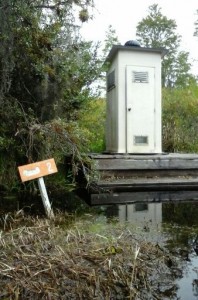 For an overview, see Canoe Map. I started from Refuge Headquarters, southwest of Folkston. At Mile Marker 2 there’s a “Porta-potty.”
For an overview, see Canoe Map. I started from Refuge Headquarters, southwest of Folkston. At Mile Marker 2 there’s a “Porta-potty.”
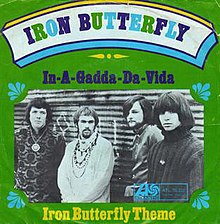
Another note: This is the “short version.” For the long version – in the manner of In-A-Gadda-Da-Vida – see the notes below.
And one more “by the way:” You’ll probably want to read the first two installments first.
Part II ended with me thinking this, as I paddled through the swamp in the dark: “That Monet guy can take his stinkin’ water lilies and ‘stick ‘em where the sun don’t shine.'”
But we digress!!!
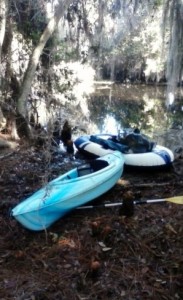 I found myself paddling through the swamp late Friday night because my timing was off. It was off because I thought my “tagalong combo” – at right – might get me charged twice. So I tried to be sneaky, and ended up paddling in the dark…
I found myself paddling through the swamp late Friday night because my timing was off. It was off because I thought my “tagalong combo” – at right – might get me charged twice. So I tried to be sneaky, and ended up paddling in the dark…
To make another long story short, my two days’ paddling-MPH turned out to be a lot slower. (A mile in 36 minutes, not 18 minutes.) So Friday afternoon I turned back early…
I was able to get back after closing. And get my rubber raft from the car, blow it up and pack it, then set off “into the sunset.”
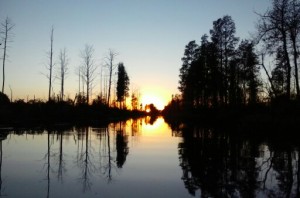
(On the Suwanee Canal, to get a photograph of a beautiful sunset.)
I didn’t get to the shelter until 8:30 or so, well after sunset. Which brings up again that the “canoe only” trail from Suwanee Canal to Cedar Hammock is loaded with water lilies…
That’s when I discovered a nasty thing about water lilies. They’re hard enough to paddle through during the day, when you can see what you’re doing…
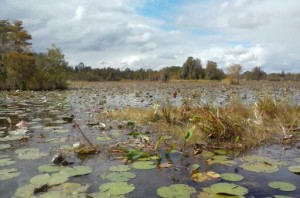 (The image at right is a picture I took of the canoe-only water trail to the Cedar Hammock shelter, during the day…)
(The image at right is a picture I took of the canoe-only water trail to the Cedar Hammock shelter, during the day…)
I found out when you paddle through water lilies in a kayak – in the dark and in a hurry – your paddle tends to grab a great wad of swamp weed. Then the paddle tosses the soggy lily-entrails – wet and cold – all about your head and shoulders.
But there were moments of beauty.
I had been after an adventure all my life, a pure dispassionate adventure, such as befell early and heroic voyagers … not knowing north from south, as strange to my surroundings as the first man upon the earth… (E.A.)
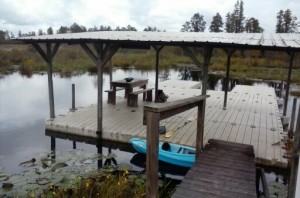 That’s Robert Louis Stevenson by the way, so I’m not the only one with such thoughts… (See 12 miles offshore.)
That’s Robert Louis Stevenson by the way, so I’m not the only one with such thoughts… (See 12 miles offshore.)
I eventually did make the Cedar Hammock shelter. (Seen at left in the daylight.) But I didn’t bring my tent because there was no place on the platform to put in stakes. And because I was in a hurry to pack. And the forecast was for no rain. And because I thought it’d be nice to camp “under the stars.” I didn’t bring any bug spray because there hadn’t been any mosquitoes any of the times I’d been at or around there before.
Fortunately I ended up getting some sleep that night. Mostly by covering myself completely with the sleeping bag. And even though a week later I was still scratching mosquito bites, mostly on my ankles. (Which was strange because they’d been covered by socks.) All the while I took some small pride in being in a place other people weren’t, and where few “normal” people dared tread. (As the saying goes, Why Be Normal?)
Next morning – Saturday – I took my time getting going. (In part because of the late night paddling, and I thought I had plenty of time.) Then I set off for the Canal Run shelter. (See Part II, including the Permits link.) On the way I found a rare spot to actually get out and stretch me legs. (And give other body parts a break as well.) That’s where I took the tagalong picture above, on a rare stretch of rather squishy-underfoot hammock along the Suwanee Canal.
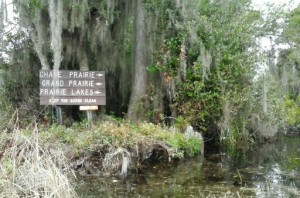 That was on the way to the “fork in the canal,” shown at left. See also the Canoe Map.
That was on the way to the “fork in the canal,” shown at left. See also the Canoe Map.
From there I set out for the Coffee Bay day shelter. (Which according to the dots on the map is three miles further west.)
The problem was that when I first got there, it was occupied. By a raucous group of adult men and teen boys, out for a day-cruise. So I set off for Mile Marker 6, got there and turned back.
My hope was that they’d be gone by the time I got back. Which worked, up to a point.
Then came the best part of the trip. I sat in my camp chair and enjoyed a sense of accomplishment. Along with the one cold beer saved from the night before. And a hearty lunch of pre-packed chicken. Not long after that I nodded off for a short nap, there in the afternoon warmth. And that one brief shining moment of happiness even survived the morning after. Or in this case the late afternoon after… (Alluding to the 1972 Maureen McGovern song.)
They say that time heals all wounds. And looking back, a month after my voyage into the Okefenokee, that seems true. Which is another way of saying the paddle-back after the nap was rushed, to say the least. But thanks to the healing power of time, the body parts that ached so much – that long Saturday afternoon of paddling – no longer seem so important. At the time I was frustrated, mostly because of the disconnect between how fast I thought I could go, and how fast I actually could go. But despite the discomfort that seems to got along with such efforts, it felt good to finally visit the home of Pogo Possum. To visit – even for such a short while – the “hollow trees amidst lushly rendered backdrops of North American wetlands, bayous, lagoons and backwoods.”
And maybe – just maybe – I got from the trip just a hint of growth. (From being merely a “misanthrope and cynic,” to develop a sense of “prickly on the outside but with a heart of gold.”)
As exemplified below. And in closing, note that my Utah brother has a brilliant idea for further adventures next summer. A 16-day, 400-plus-miles canoe trip down the Yukon River…
* * * *
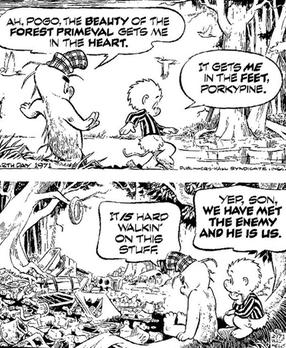
Pogo and his buddy “Porky Pine,” deep in the Okefenokee…
* * * *
The upper image is courtesy of Water Lilies (Monet series) – Wikipedia. The caption: “Le Bassin des Nympheas, 1904, Denver Art Museum.” See also Le Bassin des Nympheas (Water Lily Pond) by Claude Monet, which added: “Monet treated the water’s surface like a mirror, reflecting the swaying fringe of foliage and the clouds moving across the sky. The water spans the breadth of the composition. Only the willows and reeds that appear at the top of the canvas moor the pond to its surrounding banks.” (But they’re still a pain in the butt to paddle through…)
Re: short and long versions. See also In-A-Gadda-Da-Vida by Iron Butterfly on iTunes: “There was an under-three-minute single version, but clearly fans wanted the complete experience. Flipping the record to its first side, though, is an underrated experience.”
I took the photographs of the “tagalong” boat combo, the sunset on the Suwanee Canal, the water lilies on the way to Cedar Hammock, and the Cedar Hammock shelter itself.
The “trying to be normal” image is courtesy of: thecompellededucator.blogspot.com/2014/03 … “why be normal when you can be amazing.” And of course Maya Angelou…
The “Coffee Bay shelter image” is courtesy of orcafinntrips.blogspot.com/2012/04/suwanee-river-okefenokee-canoeing-march-2012.
The lower “enemy is us” cartoon image is courtesy of Pogo (comic strip) – Wikipedia. The caption: “Pogo daily strip from Earth Day, 1971.” In the alternative: “A 1971 Earth Day comic strip written and illustrated by Walt Kelly, featuring Pogo and Porkypine [sic].” Wikipedia described Porky Pine:
A porcupine, a misanthrope and cynic; prickly on the outside but with a heart of gold. The deadpan Porky never smiles in the strip (except once, allegedly, when the lights were out). Pogo’s best friend, equally honest, reflective and introverted, and with a keen eye both for goodness and for human foibles.
I wondered why I liked him so much…
* * * *
And now word about the subtle difference between water lilies and water hyacinths:
Water hyacinths are formally known as Eichhornia crassipes, “an aquatic plant native to theAmazon basin,” and considered “a highly problematic invasive species outside its native range.” (Fancy language for a “pain in the butt.”) Water lilies on the other hand are formally known as nymphaeaceae, a “family of flowering plants” living as “rhizomatous aquatic herbs in temperate and tropical climates around the world.”
* * * *
And finally, the “long version,” in the manner of In-A-Gadda-Da-Vida.
Picking up with, “This is the third and last installment…”
This is the third and last installment of a tale that began with Operation Pogo – “Into the Okefenokee.” It’s an account of my overnight camping trip, “deep” into the swamp. (Last October 23-24.) It included 11 hours of paddling over two days, lots of slithering alligators, and a “night operation.” (Paddling to the Cedar Hammock shelter in the dark of night.)
 For an overview, see Canoe Map. I started from Refuge Headquarters, southwest of Folkston. The Cedar Hammock shelter-image is just below Mizell Prairie. The image just below that is the “porta-potty” at Mile Marker 2, on the Suwanee Canal. (Seen at right.)
For an overview, see Canoe Map. I started from Refuge Headquarters, southwest of Folkston. The Cedar Hammock shelter-image is just below Mizell Prairie. The image just below that is the “porta-potty” at Mile Marker 2, on the Suwanee Canal. (Seen at right.)
On Friday afternoon, October 23, I paddled about half-way to Monkey Lake. (Then turned back to Headquarters to pack my camping gear.)
Saturday afternoon I got as far as Mile Marker 6, just west of the Coffee Bay shelter. And by the way, each black dot on the “trails” represents a mile. (That and other factors mean the Canoe Map is “extremely small scale.”)
 Another note: This is the long version of this tome – in some ways not unlike the long version of In-A-Gadda-Da-Vida. And one more “by the way:” You’ll probably want to read the first two installments first.
Another note: This is the long version of this tome – in some ways not unlike the long version of In-A-Gadda-Da-Vida. And one more “by the way:” You’ll probably want to read the first two installments first.
Part II of this venture ended with me “on the cusp.”
On the cusp of paddling a canoe-trail deep in the Okefenokee, in the dark, through a slough of water lilies. (The “entrails” of which blapped me; noted below.)
That’s what made me think this thought, paddling in the dark: “That Monet guy can take his stinkin’ water lilies and ‘stick ‘em where the sun don’t shine.’”
But we digress!!!
 I found myself paddling through the swamp late Friday night because my timing was off. My timing was off because I thought my “tagalong combo” – seen at right – might get me charged twice, for two “boats.” So I tried to be sneaky, andthat’s how I ended up paddling in the dark…
I found myself paddling through the swamp late Friday night because my timing was off. My timing was off because I thought my “tagalong combo” – seen at right – might get me charged twice, for two “boats.” So I tried to be sneaky, andthat’s how I ended up paddling in the dark…
There’s more on that later, but first let’s review that first morning in the swamp. (After driving down from Cordele.)
I left my camping supplies behind at the main (east) entrance, to be picked up later. Then I made a quick 3-mile preliminary paddle – sans rubber raft – to the Cedar Hammock Shelter.
Then I started out on the canoe trail to Monkey Lake. That’s where I ran across the big bull gator – almost literally – as noted in Part I:
As I paddled over over the water where the gator had been, I could swear he came up and nudged the bottom of my kayak. I figured it was an accident. (But the second time?) Thatadded some spice to the trip.
I figured I could make Monkey Lake easily that first day in the swamp. For one thing, a helpful sign along the way said it was only 5.5 miles or so. At the time I figured I could make that in a couple hours. But that’s also when I found out that my paddling-MPH on an all-day trip was a lot different than my speed on a two-hour jaunt.
Again to make a long story short, that day and the next my paddling-MPH turned out to be a lot slower. (A mile every 36 minutes, not every 18 minutes.) The result was that Friday afternoon I had to turn back early from the paddle to Monkey Lake, and paddled back to the put-in place.
I was able to get back after closing. (Per my sneaky plan.) And I did get my rubber raft from the car, blow it up and pack it, then set off literally “into the sunset.”
 (Along the Suwanee Canal entrance to the Refuge itself.) And in the process I got to photograph a really beautiful sunset, seen at left. But again, either my timing or my paddling was off.
(Along the Suwanee Canal entrance to the Refuge itself.) And in the process I got to photograph a really beautiful sunset, seen at left. But again, either my timing or my paddling was off.
I didn’t get to the shelter until 8:30 or so, well after sunset. Which brings up again that the “canoe only” trail from Suwanee Canal to Cedar Hammock is loaded with water lilies…
When I left the east entrance put-in, I thought I had plenty of time. (Laboring under the delusion that I could make three miles in 54 minutes; 18 minutes per mile.) Sunset was supposed to be about 7:00 p.m., and “last light” about 7:30. But it took a tad longer than I expected. One of the reasons was those stinkin’ water lilies…
That is, in this venture I discovered a very nasty thing about water lilies. They’re hard enough to paddle through during the day, when you can see what you’re doing…
 (The image at right is a picture I took of the canoe-only water trail to the Cedar Hammock shelter, during the day…)
(The image at right is a picture I took of the canoe-only water trail to the Cedar Hammock shelter, during the day…)
Then too, the strange thing is that while I was paddling on the way back from Monkey Lake, I visualized how much fun it might be to “conduct a night operation.” (To paddle through the beautiful Okefenokee at night.)
Which brings up the old saying: “Be careful what you wish for.”
Which is being interpreted: I found out that if you’re both in a hurry – as I was – and can’t see what you’re doing, your paddle tends to gouge out great tendrils of “swamp weed.”
That’s what I call the stuff that grows down under the lilies. (As opposed to “sea weed.”)
I found out that when you try to paddle through water lilies in a kayak – in the dark and in a hurry – your paddle tends to grab a great wad of swamp weed and toss it – soggy and cold – all about your head and shoulders. (Not always. Just enough to keep you off balance…)
Which made for a long hour of paddling, with the last mile or so through a never-ending sea of water lilies. But there were moments of beauty. Every once in a while along the way I’d stop paddling. (I am retired after all.) Partly to rest my arms and shoulders. Partly to get a break from being blapped by water-lily entrails. But a big part of it was simply to stop and appreciate the ambience. It really was beautiful, in the middle of the Okefenokee in the moonlight:
I had been after an adventure all my life, a pure dispassionate adventure, such as befell early and heroic voyagers … not knowing north from south, as strange to my surroundings as the first man upon the earth…
 That’s Robert Louis Stevenson by the way, so I’m not the only one with such thoughts… (See 12 miles offshore.)
That’s Robert Louis Stevenson by the way, so I’m not the only one with such thoughts… (See 12 miles offshore.)
I eventually did make the Cedar Hammock shelter. (Seen at left in the daylight. My kayak –sans “tagalong” – is near the bottom of the picture.)
That’s when I found out that I should have brought something for the mosquitoes. I did bring a cooler with four beers and two sandwiches. (Along with some “dry good” food.) And that first beer tasted really great, in the process of unpacking.
Also, I brought a “night light,” a small flashlight that attaches to the bill of your camp. But I didn’t bring my tent, or bug spray, or mosquito netting.
I didn’t bring the tent because there was no place on the platform to put in stakes. And because I was in a hurry to pack. And the forecast was for no rain. And because I thought it’d be nice to camp “under the stars.” I didn’t bring any bug spray because there hadn’t been any mosquitoes any of the times I’d been at or around there before. (And besides, bobandrobin had said, “We didn’t need the bug spray today…”)
Fortunately I ended up getting some sleep that night. Mostly by covering myself completely with the sleeping bag. And even though a week later I was still scratching bites, mostly on my ankles. (Which was strange because they’d been covered by socks.)
And again there was a great deal of beauty to appreciate. I alternated between hiding under the sleeping bag and sitting in my camp chair, drinking a beer and slapping mosquitoes. The first part of the night featured a full moon. (Which came in handy when paddling through the water lilies. And that full moon may have helped me not lose my way.) And that first part of the night the full moon lit up the swamp rather prettily…
Later the moon went down. And with no artificial light around, the stars sparkled just out of reach.
All the while I took some small pride in being some place other people weren’t, and where few “normal” people dared tread. (As the saying goes, Why Be Normal?) The next morning – Saturday – I took my time getting up and going. (In part because of the late night paddling, and because I thought I had plenty of time.) In lieu of coffee I had a Coke Zero, and for breakfast a couple of granola bars. I had a single-serve packet of chicken for lunch, later on. And I’d saved one last beer, to enjoy with lunch.
Then I set off for the Canal Run shelter. (See Part II, including the Permits, link. And as per my plan to “bisect” the swamp later trip, via Foster State Park – Fargo.) On the way I found a rare spot to actually get out of my kayak and stretch me legs. (And give other body parts a break.) That’s where I took the tagalong picture above, on a rare stretch of rather squishy-underfoot hammock along the Suwanee Canal.
 That was on the way to the “fork in the canal,” shown at left. See also the Canoe Map. The fork in the canals shown at right is just below and slightly to the right of the “porta-potty” image shown above.
That was on the way to the “fork in the canal,” shown at left. See also the Canoe Map. The fork in the canals shown at right is just below and slightly to the right of the “porta-potty” image shown above.
From there I set out for the Coffee Bay day shelter. Which according to the dots on the map is three miles further west.
I ended up getting to Mile Marker 6, that apparently marks six miles from the start of the National Wildlife Refuge, not the put-in place with rental boats, cafe and gift shop. (According to the dots on the map.) Then I went back and enjoyed some much needed “leg-stretching.”
The problem was that when I first got to the day shelter, it was occupied. By a group of adult men and teen boys, out for a day-cruise adventure. So I set off for Mile Marker 6, got there and turned back, all in the hope that they’d be gone by that time.
The plan worked, up to a point. I only had to dodge a couple of BB-gun shots by the ardent young sportsmen. (Not to mention the usual teen-boy goofballing.) But then the group departed in its three canoes, and the Okefenokee was quiet again.
Then came the best part of the trip. I sat in my camp chair – packed in the rubber raft – and enjoyed a sense of accomplishment. Along with the one cold beer saved from the night before. And a hearty lunch of pre-packed chicken.
Not long after that I nodded off for a short nap, there in the afternoon warmth. And that one brief shining moment of happiness even survived the morning after. Or in this case the late afternoon after… (Alluding to the 1972 Maureen McGovern song.) Which is being interpreted:
I spent the rest of the afternoon and early evening rushing to get back to my car at the put-in place. I made it time to leave before dark, but not to enjoy a much-anticipated burger, fries and cold drink at the cafe. That came later, much later, as I drove my way back home.
They say that time heals all wounds. And looking back, a month after my voyage into the Okefenokee, that seems true. The body parts that ached so much – that long Saturday afternoon of paddling – no longer seem so important.
At the time I was frustrated, mostly because of the disconnect between how fast I thought I could go, and how fast I actually could go. (Which BTW is a theme repeated on the just-completed, two-day Appalachian Trail hike. The subject of my next blog-post.)
On the other hand, maybe that’s part of the process. Maybe such disconnects come with the territory of fulfilling a life-long dream. (See Part I.)
Despite the discomfort that came with the effort, it felt good to finally visit the home of Pogo Possum. To visit – even for such a short while – the “hollow trees amidst lushly rendered backdrops of North American wetlands, bayous, lagoons and backwoods.”
And maybe – just maybe – I got from the trip just a hint of growth from being the “misanthropeand cynic,” and from there develop a sense of “prickly on the outside but with a heart of gold…” And in closing, note that my Utah brother has a brilliant idea for further adventures next summer. A 16-day, 400-plus-miles canoe trip down the Yukon River…
* * * *
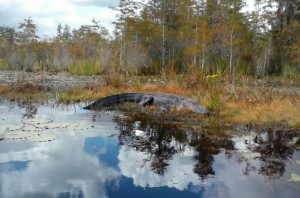
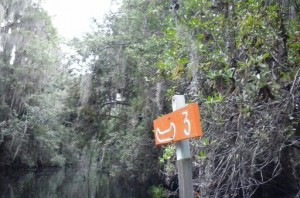 Remember that I’d made Mile-Marker Three – at right – in 54 minutes the first time I visited. (See
Remember that I’d made Mile-Marker Three – at right – in 54 minutes the first time I visited. (See 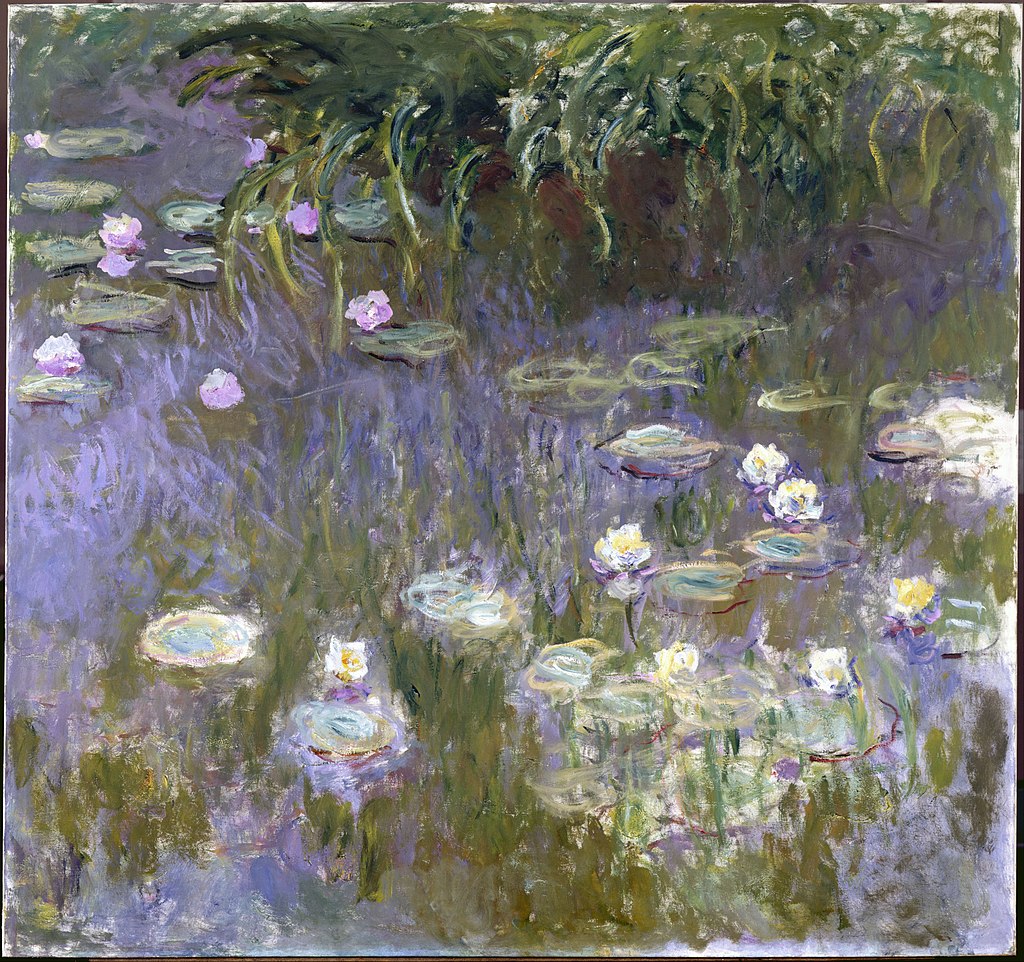
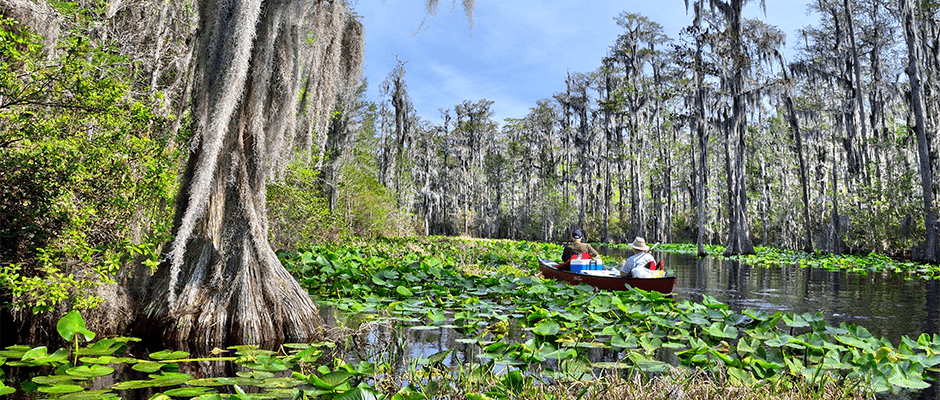
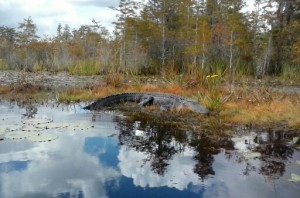 Which leads to the fact that the “shore where the gators bask” – noted above and as shown at left – was not really a
Which leads to the fact that the “shore where the gators bask” – noted above and as shown at left – was not really a  Another time – just before he drove into Chicago to meet his wife at the Ambassador East – Steinbeck was relaxing where he’d pulled over to make coffee. (Beside a lake of clear, clean water.) Then, “A young man in boots, corduroys” and a mackinaw came up; “Don’t you know this land is posted? This is private property.” Steinbeck ended up camping there, after a “bribe … with a cup of coffee.” Coffee, that is, with a “dollop of
Another time – just before he drove into Chicago to meet his wife at the Ambassador East – Steinbeck was relaxing where he’d pulled over to make coffee. (Beside a lake of clear, clean water.) Then, “A young man in boots, corduroys” and a mackinaw came up; “Don’t you know this land is posted? This is private property.” Steinbeck ended up camping there, after a “bribe … with a cup of coffee.” Coffee, that is, with a “dollop of 